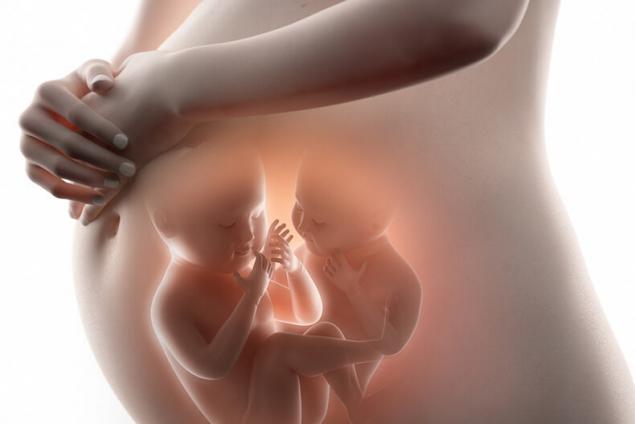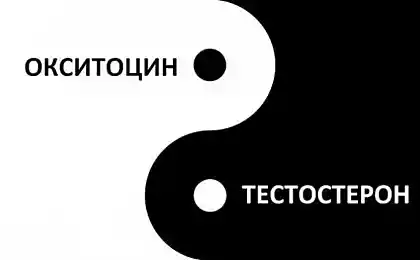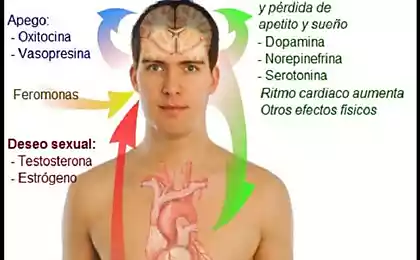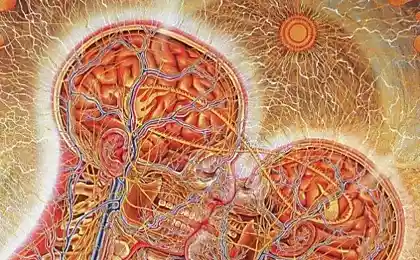404
"Shy Hormone" Oxytocin
Let's discuss why childbirth should be approached in some special way, when compared to the birth of other mammals. If we talk about the birth of children exclusively from the point of view of physiology, we will focus on the basic needs of a woman in childbirth, as well as the basic needs of a newborn child.
Their needs are essentially the universal needs of a mammal. But there are differences in the birth of humans and other mammals. These differences are easily demonstrated.

Let me start with some of the experiments. These experiments give fairly clear conclusions about the consequences of any intervention in the birth of a mammal. If this happens, the female does not recognize the newborn baby as her own. It's a fact.
The effect of intervention in the process of childbirth is easily demonstrated at the level of the individual, at the level of the individual. Another example. If an epidural is used in a normal birth of a female mother, she is not interested in her child in the future. She does not show maternal behavior, she does not feed her baby with her milk. Same thing.
Now let's look at primates (except humans). Monkey mothers who gave birth to their babies by caesarean section were later simply uninterested in their newborn babies. These cubs could only survive if they were cared for by humans.
Thus, the effect of intervention in the genera of mammals at the individual level is quite easy to see. And it's very easy to explain, if you take a physiological approach, to look at it in terms of physiology.
As you know, for the safe birth of a child, a baby, mammals (including humans) usually secrete a whole cocktail of hormones. Among many others, one of the major hormones in this complex complex is hormone. The effect of this hormone on human behavioral responses has been studied and documented in scientific studies.
Based on the findings of these studies, we can call oxytocin the typical, most characteristic love hormone. It is oxytocin that encourages mammals to take care of their children. If there is an intervention in childbirth, the hormonal balance is also disturbed. This should not surprise anyone, this fact could be assumed.
Now that we know the results of animal experiments, let’s look at what happens when a human baby is born. It turns out that things are much more complicated for people!
Millions of women have given birth under epidurals. They still take care of their children. Millions of babies were born by C-section, and their mothers also care for their babies. I mean, it's not that simple with people. Why is it more difficult for humans than other mammals?
Because people tend to talk, they have quite complex, quite diverse ways of communicating. And they also create cultures. In certain situations, especially during the perinatal period (the time spanning the short period before birth, the birth itself, and the short period after), human behavior is less affected by hormonal levels than in animals.

It is directly influenced by the cultural environment. So, for example, if a woman is pregnant, she knows about it, she can somehow imagine in advance that she will be a mother. Humans use methods that other mammals cannot use. Mammals do not know what they will give birth, they do not expect their child.
On the day when a cocktail of love hormones is released inside the female’s body, she shows interest in her baby. Here lies the most striking difference between man and other mammals. So when it comes to human beings, we need to take into account the cultural dimension. The concept of civilization.
I do not mean to say that one cannot learn anything from observations and experiments with animals. Thanks to them, we can formulate the most important questions concerning the birth of human children, but we must always take into account the civilizational aspect.
Female mammals do not care for their offspring if they gave birth under anesthesia, epidural. What then is the future of generations of people born under epidurals?
The same applies to childbirth by caesarean section. When a cesarean section gives birth to one or two children, it does not cause alarm. But what happens if all children are born Caesarean? In other words, what is the future of a civilization born by caesarean section? Because now we're in a completely unprecedented situation, a turning point in the history of childbearing. At a turning point in the history of civilization and humanity.
Our top priority today is to ask the right questions. So, why are we at a key point in human development? All, or almost all, civilizations known to us have radically interfered with the process of procreation through beliefs, rituals, and the like. But today something new has emerged that we did not know or observe until recently.
To give birth to a child, a woman of a past era had to rely on a complex set of hormones. And, having not isolated this cocktail from oxytocin, endorphin, vasoprisin and other hormones, the woman simply was not able to produce offspring. Suddenly, the situation has changed radically.
The vast number of women who used to rely on their own hormones to give birth to a baby and then give birth to the placenta are gradually heading towards zero. I specifically focus on the subsequent birth of the placenta.
Scientific studies, primarily Swedish scientists, have revealed the fact that the highest level of oxytocin, the moment when the greatest amount of the love hormone is released (a woman does not release this hormone at this level at any other time), is observed immediately after the birth of a child. And one of the roles that is destined for this hormone, released in such quantities immediately after birth, is to make it possible and facilitate the departure and birth of the placenta.
Thus, At the planetary level, the number of women who can give birth to a baby and placenta thanks to their own hormones is steadily approaching zero. There are already places in the world where giving birth to a baby by caesarean section is the most common way.
So, for example, the situation is in most cities in Latin America, China, in general in the entire south-west of China, in South Korea, and some European countries. Here we can highlight southern Italy. So in a large part of the world, cesarean section is the main way to give birth to children. But in other countries of the world, the level of cesarean sections is steadily increasing.
The number of women who are able to secrete a cocktail of hormones provided by nature during vaginal birth is steadily decreasing. And this happens precisely because the release of hormones, in particular oxytocin, is greatly influenced by factors of a woman’s external environment.
The external environment in a large number of cases has a negative effect on the process of excretion of oxytocin, and a woman giving birth by vaginal means needs synthetic substitutes for those hormones that she could isolate herself. She is injected into a vein with synthetic oxytocin instead of excreting it herself.
In addition, in the case of epidural anesthesia, it is administered analgesics that replace endorphins. All these injected substances block the release of her own hormones, but do not have an equivalent effect on a woman’s behavior. Even if a woman is lucky enough to have a baby on her own hormones, even in the poorest countries, she is very likely to be given oxytocin for the safe birth of the placenta.
Thus, at the moment when a woman is able to have the highest level of love hormones, her ability to release these hormones will be neutralized. Such a situation has never happened in the history of mankind!
I repeat that the number of women who gave birth to a child on their own hormones, and subsequently the placenta, is steadily decreasing. This is a turning point in the history of childbirth, and a turning point in the history of our species. If we are aware of the situation we are in today, it will be easy for us to formulate the questions we need to ask ourselves.
Human beings are so intelligent, so imbued with intelligence, and so inventive that they have rendered the natural hormones of love useless. Love hormones become unnecessary at the most critical moment when a person’s ability to love develops. All scientific disciplines that have ever been interested in the concept of love emphasize the great importance of the perinatal period. In this state of affairs, children will soon be born without the need for the hormone of love.
In my opinion, this is one of the most important questions that we must ask ourselves. We need to develop a new understanding of the facts, a new awareness in order to understand what is happening at this critical moment. Why do I emphasize the importance of civilization in relation to human birth? To quantify obstetric and gynecological practice, we use only generally accepted criteria.
We can say that these are the criteria of the twentieth century. Morbidity and mortality rates during the perinatal period, as well as maternal morbidity and mortality, also take into account material costs — all the criteria that are used to assess how the birth has occurred. C-sections are now reliable, safe, and fast, and are now safer than ever.
And if you evaluate the situation only on the given criteria, it would be necessary to prescribe every woman giving birth a caesarean section, give her a free choice. This approach has become widespread and even accepted in many countries of the world. In the medical literature, there are more and more scientific studies that compare the reliability, safety of cesarean section with other ways of birth.
According to some statistical studies that have been conducted in the UK and the US, more and more women who are obstetrician-gynecologists by profession are opting for a caesarean section as the way they would like to have their own baby, an elective caesarean section, on request. You can understand their choices. They have received appropriate medical education and, accordingly, think in familiar terms.
That is why it is necessary to develop other views on this subject, to learn to think in terms of civilization. In medical circles, this is a very, very difficult task. Since the era of Hippocrates, the doctor sees a single person in front of him. And if anyone understands the need for new criteria, other criteria with which to approach the circumstances of the birth of a person, it is, of course, sociologists. That’s why I pay so much attention to the new criteria.
In other circles, I would probably start my talk by thinking long-term. For example, if I talked to epidemiologists about it. I am referring to a new branch of epidemiology, primary health research. It includes all studies of the correlation between what happens at the very beginning of our lives and what happens later in life. Both in terms of health and in terms of human character. It is for the sake of such research that a research center in London was established.
Let me focus on what I mean when I say “at the beginning of our lives.” This is called the primary period. It includes intrauterine life, the perinatal period (that is, shortly before and immediately after birth), and one year after the birth of a person. And if you look at the database of the Institute of Primary Health today, you can find many studies in which scientists conclude that the way we were born has lifelong consequences for our lives.

So apart from the influence of civilization, we have to think about the long-term consequences of the circumstances of birth. And if we use new criteria, if we take into account the circumstances: how safely a woman carried and gave birth to a child, how safely she then breast-feeding took place, if we expand the list of criteria used, we can conclude that, despite the safety of cesarean section surgery, despite the impressive successes of pharmacology, nevertheless, we need to interfere with the process of childbirth as little as possible.
We have all the data we need to understand the basic needs of a woman giving birth. And also to realize, to discover the basic needs of a newborn child. I use the word rediscover because after thousands of years of culturally-based interventions in childbearing, we have completely forgotten what the needs of a child and a woman are. And you have to turn around and look at the cultural environment.
What does a child who has just been born need the most? According to the latest scientific data, the first physical contact between the mother and the newborn is very important. This is an extremely important point in the formation of attachment of the child and mother. But most societies have forgotten this.
Almost at all times and in all cultures, the child was immediately carried away from the mother, neglected one of the basic needs of the newborn. There were many ways to do this: there were traditions, there were some rituals. You can spend a whole day talking about how different societies and different civilizations interfered with the first contact of a mother and a newborn baby.
I often start with the same example to show how just a firm belief can be devastating to a newborn. There is a long and very firmly established belief that colostrum is harmful. But the most recent scientific evidence suggests that it is an invaluable substance.
In many human societies, this substance is considered harmful, bad. And this belief is passed down from generation to generation, from mouth to mouth. It follows that as soon as the baby is born, it must be urgently taken away, not given to the mother, urgently handed over to someone else. And to do that, you have to invent rituals, and these rituals are extremely common.
Another such ubiquitous ritual is to immediately rush to cut the umbilical cord.
These are just a few examples, and there are thousands of them. How an ingrained belief can have a profound impact on the birth process. There is something in common between all these interventions. All the time the same motive is to separate the child from the mother.
Thus, if we want to understand the basic needs of a woman and her baby in childbirth, we have no right to rely on any of the culturally conditioned models. The only way is to study through fairly rapidly developing scientific disciplines.
The first is physiology. It may seem strange to some of you to bring in physiologists to justify the fact that a newborn baby needs a mother! But because mother and child have been separated for centuries and millennia, a scientific approach is needed to prove such obvious facts. So what can physiologists give us today?
These are, first of all, the basic needs of a woman in childbirth and the needs of a newborn baby in terms of being mammals, therefore, have a number of characteristics that are universal for all mammals. That's where we have to start! Because certain laws concerning all mammals living on Earth apply to man, because he is the same.
One very simple example from the point of view of physiologists. From observations of mammals we are well aware of this fact. At a time when mammals secrete adrenaline into the blood (I would also mention catecholamines, hormones of the adrenaline group), they cannot release oxytocin.
So what do we get? Adrenaline is an emergency hormone, the hormone of anxiety and unhappiness, and mammals release it into their bloodstream in certain situations in their lives, particularly when they are frightened, watched (and they feel it), or when they are cold. And oxytocin is not produced under such conditions. Such a generally accepted and undisputed physiology of things.
And as you already know, oxytocin is the most important hormone for the birth process. Because it is necessary for uterine contractions, and also because it is the main hormone of love. Based on these facts, we easily understand the basic needs of a woman giving birth, and they are universal for all mammals.
In order to give birth safely, a woman needs to feel safe, not feel that someone is watching her, and be in a warm enough place. I have given this example to emphasize that what we draw from physiology are very simple, widely known truths. But in practice, however, these truths have to be rediscovered.
We also learn from physiologists that the release of oxytocin has its own characteristics. The nature of the release of the hormone oxytocin to an extremely high degree depends on environmental factors. We can say that oxytocin is a “shy” hormone. He behaves just like a shy person. In the same way, the unattainable and the modest will prefer not to appear among strangers, in unfamiliar surroundings. Obviously, this is completely forgotten when it comes to the birth of a human baby. In other situations, we understand this, but in childbirth, we don’t.

Oxytocin is released in some other episodes of our lives. This occurs during sexual intercourse, both partners secrete significant doses of oxytocin. And anthropologists have long observed that even in societies where genital sex is not severely restricted, people tend to seclude in order to engage in it.
Perhaps some of you have read (or at least heard) Malinowski’s book The Sexual Life of Savages. This book came out in 1929. So in the communities he described, genital contact was fairly simple and unlimited. But, nevertheless, for sex, they retreated somewhere in the bushes. Apparently, they know that Oxytocin is a shy hormone.
Now back to childbirth. All mammals, except humans, behave in childbirth as if they know that oxytocin is a shy hormone. They all have the same strategy - to provide privacy so that no one is watching and no one is in the way. These are universal limitations for all mammals except humans.
What about the man? Apparently, at some stage of human development, women behaved during childbirth like other mammals. Are there any anthropologists among you? Have any of you seen a film by German anthropologist Wolf Schifenhöller of the Max Mark Institute?
I first saw this movie in 1978. They filmed the birth of a woman in New Guinea, a tribe of apples. They saw a woman crawling into the bushes. She tramples the grass and makes herself a kind of nest, and there, in the bushes, the baby is allowed. Anthropologists have documented the fact that there was a phase of human development, when women in labor retreated, remaining completely alone, leaving their community, their family.
In somewhat more developed, more complex societies, there are special huts where women come to give birth. I have even heard that in traditional societies in Russia, in northern Russia, women go to the bathhouse to give birth, or to the barn. They always left the place they were every day.
But when it comes to childbirth, a woman prefers to give birth near her own mother. Next to your own mother, or a woman experienced in these matters, or your grandmother. That is, for a woman in childbirth, a certain kind of mother figure must be present, which will fence off, protect from strangers, and will not allow someone else to intervene. As a rule, we are not ashamed of our mother.
And, apparently, it is from this need that obstetrics arose. In its original form, the midwife personifies the mother.
But later a different approach to childbirth developed, and many more people were present in childbirth. It seems that for thousands of years, people have forgotten that they have a “shy” hormone, an underachieving hormone. There were several steps by which the people were added to the maternity ward.
For starters, the midwife has become a man increasingly prescribing the rules, controlling the birth process. In this way, it became an agent of a cultural environment that broadcasts cultural traditions, prejudices and so on. There was a time when women were told to stay at home during childbirth. This is the next phase of childbirth socialization.
In the history of childbearing, home birth is a fairly recent stage. In the twentieth century, everything went up like a rocket! Socialization of childbirth, too. Until the middle of the twentieth century, it was still remembered that oxytocin is less “shy” when only women surround the woman in labor. And then the medical environment and the environment surrounding the woman in childbirth became more and more masculine.
Even 100 years ago, childbirth was a woman’s business. Today, a woman in labor is often surrounded by doctors-specialists only male. In many countries (I don’t mean Russia, where the situation is somewhat different), most of the specialists who give birth are men.

The idea was also born that the most complex electronic machines should take part in childbirth. And high technology just went into every maternity ward.
Thus, humanity has completely forgotten that it is dealing with a rather “shy” hormone. Recently, another step towards socialization of childbirth has taken place. It's an epidemic -- an epidemic of video. Video of a natural birth.
You look at the woman in labor, and there are three people around her. It's happening at home - you have to film her kneeling and then film her climbing into the pool. They call it natural birth! A less natural environment for a woman in labor is hard to come up with.
Women will watch this video and come to the idea that in a normal safe birth, there should be two, three, four people next to her. And of course, there's a cameraman.
Well, what it's like to have a baby on camera with a few other people standing around watching you. How do you explain to people that the main factor that ensures the well-being of childbirth is privacy, privacy and safety? A woman will look at this, and she will get the impression that the main factor of a successful birth is support. Thus, it is important to recognize the fact that oxytocin is a “shy” hormone.
There is a third view, a physiology view. I want to end with this point, because here we will talk about the peculiarities inherent only in man. If you know, science at today's level of development regards humans -- homo sapiens -- in fact as chimpanzees with an overdeveloped (even overdeveloped) cerebral cortex. But the part of the brain that we call the neocortex, the new cerebral cortex, is three times larger than the rest of the chimpanzees. Why does this difference cause difficulty in childbearing?
During childbirth, as well as during all other cases that affect our sexual life, inhibition occurs from the new cerebral cortex (neocortex). That is, it comes from the part of the brain that is responsible for intelligence. So what do we need to understand? What is the solution to overcome this negative difference? The solution is that during childbirth, the neocortex should be given a rest. Childbirth is not for the intellect, it is not his business. .
Perhaps many of you know that a woman who gives birth on her own with the help of her own hormones, at some point in the birth comes a complete disconnection from the outside world. She forgets what is going on around her, she forgets what she was taught, she forgets her plans. She behaves in such a way that in another situation this behavior could be called indecent. It's not customary!
From the point of view of a civilized woman, she behaves absolutely obscene: she can squeal, she can swear, she will even be impolite. She can also take the most unexpected and exotic poses. Very often she suddenly finds herself on all fours, like all her mammals. When a woman is in childbirth, she is on another planet.
If this happens, it means that she has managed to minimize the activity of her neocortex. And this reduction in neocortical activity is one of the most important aspects of the physiology of childbirth in general, and human birth in particular. From a practical point of view, the awareness and understanding of this fact gives us the answer to the question, what are the basic needs of women in childbirth.
A woman giving birth needs someone to protect her from stimulating her intelligence, her neocortex. To avoid this, let’s briefly recall what are the main factors that stimulate the activity of the neocortex.
Specifically, the human stimulator of the new cerebral cortex is human speech, verbal communication. Thus, we must discover the need for a woman to remain silent. Next to a woman giving birth, speech should be used with very, very great care. It takes some time to realize how much a woman in childbirth needs silence and silence. Especially after millennia of birth control by different cultures.
Another powerful stimulator of the neocortex is bright light. We need to understand another woman’s need for childbirth: the need for dimmed light. This is especially important in an era where electricity is everywhere. We do not need to press a button and make the darkness bright.
Do we understand how much this interferes with physiological processes? In addition, the neocortex becomes more active when we feel that we are being watched. In this case, we begin to observe ourselves.
It is appropriate to repeat that oxytocin is a “shy” hormone. One of the most important needs of a woman is that no one watches her. The neocortex is involved in the process of detecting possible danger. When we feel that we are being watched, we direct all our attention to it and fall into a state of anxiety. Remember that oxytocin and adrenaline are antagonists. In order to give birth safely, a woman needs to feel safe.
So, as we've seen so far -- I'm going back to what we said at the beginning -- we need a multidisciplinary approach to this problem. We need to talk in terms of cultures, in terms of civilizations. We also need an epidemiological approach.
We also discussed the physiological approach that we need to focus on all the time. The physiological state is a kind of “zero point,” something to which we compare everything else. And from this state we need to deviate as little as possible. Physiologists study exactly what is not different in people of different cultures. Physiology does not know cultural differences, if the process is physiological, it will be the same in Tokyo and Moscow.
Chemistry of the body: oxytocin – the hormone of trustN.V.Startseva: Obstetric aggression
However, we must not forget the differences in cultures. We need to remember how the cultural environment can interfere with childbirth. But we can't understand how society works unless we have some kind of reference pattern, a physiological process. Therefore, anthropologists, demographers, ethnographers, sociologists must have before their eyes a certain point of reference — physiological. To understand what underlies what is universal.published
Credit: Michel Oden
Source: pravotnosheniya.info/Zastenchiviy-gormon-oksitotsin-3777.html
Their needs are essentially the universal needs of a mammal. But there are differences in the birth of humans and other mammals. These differences are easily demonstrated.

Let me start with some of the experiments. These experiments give fairly clear conclusions about the consequences of any intervention in the birth of a mammal. If this happens, the female does not recognize the newborn baby as her own. It's a fact.
The effect of intervention in the process of childbirth is easily demonstrated at the level of the individual, at the level of the individual. Another example. If an epidural is used in a normal birth of a female mother, she is not interested in her child in the future. She does not show maternal behavior, she does not feed her baby with her milk. Same thing.
Now let's look at primates (except humans). Monkey mothers who gave birth to their babies by caesarean section were later simply uninterested in their newborn babies. These cubs could only survive if they were cared for by humans.
Thus, the effect of intervention in the genera of mammals at the individual level is quite easy to see. And it's very easy to explain, if you take a physiological approach, to look at it in terms of physiology.
As you know, for the safe birth of a child, a baby, mammals (including humans) usually secrete a whole cocktail of hormones. Among many others, one of the major hormones in this complex complex is hormone. The effect of this hormone on human behavioral responses has been studied and documented in scientific studies.
Based on the findings of these studies, we can call oxytocin the typical, most characteristic love hormone. It is oxytocin that encourages mammals to take care of their children. If there is an intervention in childbirth, the hormonal balance is also disturbed. This should not surprise anyone, this fact could be assumed.
Now that we know the results of animal experiments, let’s look at what happens when a human baby is born. It turns out that things are much more complicated for people!
Millions of women have given birth under epidurals. They still take care of their children. Millions of babies were born by C-section, and their mothers also care for their babies. I mean, it's not that simple with people. Why is it more difficult for humans than other mammals?
Because people tend to talk, they have quite complex, quite diverse ways of communicating. And they also create cultures. In certain situations, especially during the perinatal period (the time spanning the short period before birth, the birth itself, and the short period after), human behavior is less affected by hormonal levels than in animals.

It is directly influenced by the cultural environment. So, for example, if a woman is pregnant, she knows about it, she can somehow imagine in advance that she will be a mother. Humans use methods that other mammals cannot use. Mammals do not know what they will give birth, they do not expect their child.
On the day when a cocktail of love hormones is released inside the female’s body, she shows interest in her baby. Here lies the most striking difference between man and other mammals. So when it comes to human beings, we need to take into account the cultural dimension. The concept of civilization.
I do not mean to say that one cannot learn anything from observations and experiments with animals. Thanks to them, we can formulate the most important questions concerning the birth of human children, but we must always take into account the civilizational aspect.
Female mammals do not care for their offspring if they gave birth under anesthesia, epidural. What then is the future of generations of people born under epidurals?
The same applies to childbirth by caesarean section. When a cesarean section gives birth to one or two children, it does not cause alarm. But what happens if all children are born Caesarean? In other words, what is the future of a civilization born by caesarean section? Because now we're in a completely unprecedented situation, a turning point in the history of childbearing. At a turning point in the history of civilization and humanity.
Our top priority today is to ask the right questions. So, why are we at a key point in human development? All, or almost all, civilizations known to us have radically interfered with the process of procreation through beliefs, rituals, and the like. But today something new has emerged that we did not know or observe until recently.
To give birth to a child, a woman of a past era had to rely on a complex set of hormones. And, having not isolated this cocktail from oxytocin, endorphin, vasoprisin and other hormones, the woman simply was not able to produce offspring. Suddenly, the situation has changed radically.
The vast number of women who used to rely on their own hormones to give birth to a baby and then give birth to the placenta are gradually heading towards zero. I specifically focus on the subsequent birth of the placenta.
Scientific studies, primarily Swedish scientists, have revealed the fact that the highest level of oxytocin, the moment when the greatest amount of the love hormone is released (a woman does not release this hormone at this level at any other time), is observed immediately after the birth of a child. And one of the roles that is destined for this hormone, released in such quantities immediately after birth, is to make it possible and facilitate the departure and birth of the placenta.
Thus, At the planetary level, the number of women who can give birth to a baby and placenta thanks to their own hormones is steadily approaching zero. There are already places in the world where giving birth to a baby by caesarean section is the most common way.
So, for example, the situation is in most cities in Latin America, China, in general in the entire south-west of China, in South Korea, and some European countries. Here we can highlight southern Italy. So in a large part of the world, cesarean section is the main way to give birth to children. But in other countries of the world, the level of cesarean sections is steadily increasing.
The number of women who are able to secrete a cocktail of hormones provided by nature during vaginal birth is steadily decreasing. And this happens precisely because the release of hormones, in particular oxytocin, is greatly influenced by factors of a woman’s external environment.
The external environment in a large number of cases has a negative effect on the process of excretion of oxytocin, and a woman giving birth by vaginal means needs synthetic substitutes for those hormones that she could isolate herself. She is injected into a vein with synthetic oxytocin instead of excreting it herself.
In addition, in the case of epidural anesthesia, it is administered analgesics that replace endorphins. All these injected substances block the release of her own hormones, but do not have an equivalent effect on a woman’s behavior. Even if a woman is lucky enough to have a baby on her own hormones, even in the poorest countries, she is very likely to be given oxytocin for the safe birth of the placenta.
Thus, at the moment when a woman is able to have the highest level of love hormones, her ability to release these hormones will be neutralized. Such a situation has never happened in the history of mankind!
I repeat that the number of women who gave birth to a child on their own hormones, and subsequently the placenta, is steadily decreasing. This is a turning point in the history of childbirth, and a turning point in the history of our species. If we are aware of the situation we are in today, it will be easy for us to formulate the questions we need to ask ourselves.
Human beings are so intelligent, so imbued with intelligence, and so inventive that they have rendered the natural hormones of love useless. Love hormones become unnecessary at the most critical moment when a person’s ability to love develops. All scientific disciplines that have ever been interested in the concept of love emphasize the great importance of the perinatal period. In this state of affairs, children will soon be born without the need for the hormone of love.
In my opinion, this is one of the most important questions that we must ask ourselves. We need to develop a new understanding of the facts, a new awareness in order to understand what is happening at this critical moment. Why do I emphasize the importance of civilization in relation to human birth? To quantify obstetric and gynecological practice, we use only generally accepted criteria.
We can say that these are the criteria of the twentieth century. Morbidity and mortality rates during the perinatal period, as well as maternal morbidity and mortality, also take into account material costs — all the criteria that are used to assess how the birth has occurred. C-sections are now reliable, safe, and fast, and are now safer than ever.
And if you evaluate the situation only on the given criteria, it would be necessary to prescribe every woman giving birth a caesarean section, give her a free choice. This approach has become widespread and even accepted in many countries of the world. In the medical literature, there are more and more scientific studies that compare the reliability, safety of cesarean section with other ways of birth.
According to some statistical studies that have been conducted in the UK and the US, more and more women who are obstetrician-gynecologists by profession are opting for a caesarean section as the way they would like to have their own baby, an elective caesarean section, on request. You can understand their choices. They have received appropriate medical education and, accordingly, think in familiar terms.
That is why it is necessary to develop other views on this subject, to learn to think in terms of civilization. In medical circles, this is a very, very difficult task. Since the era of Hippocrates, the doctor sees a single person in front of him. And if anyone understands the need for new criteria, other criteria with which to approach the circumstances of the birth of a person, it is, of course, sociologists. That’s why I pay so much attention to the new criteria.
In other circles, I would probably start my talk by thinking long-term. For example, if I talked to epidemiologists about it. I am referring to a new branch of epidemiology, primary health research. It includes all studies of the correlation between what happens at the very beginning of our lives and what happens later in life. Both in terms of health and in terms of human character. It is for the sake of such research that a research center in London was established.
Let me focus on what I mean when I say “at the beginning of our lives.” This is called the primary period. It includes intrauterine life, the perinatal period (that is, shortly before and immediately after birth), and one year after the birth of a person. And if you look at the database of the Institute of Primary Health today, you can find many studies in which scientists conclude that the way we were born has lifelong consequences for our lives.

So apart from the influence of civilization, we have to think about the long-term consequences of the circumstances of birth. And if we use new criteria, if we take into account the circumstances: how safely a woman carried and gave birth to a child, how safely she then breast-feeding took place, if we expand the list of criteria used, we can conclude that, despite the safety of cesarean section surgery, despite the impressive successes of pharmacology, nevertheless, we need to interfere with the process of childbirth as little as possible.
We have all the data we need to understand the basic needs of a woman giving birth. And also to realize, to discover the basic needs of a newborn child. I use the word rediscover because after thousands of years of culturally-based interventions in childbearing, we have completely forgotten what the needs of a child and a woman are. And you have to turn around and look at the cultural environment.
What does a child who has just been born need the most? According to the latest scientific data, the first physical contact between the mother and the newborn is very important. This is an extremely important point in the formation of attachment of the child and mother. But most societies have forgotten this.
Almost at all times and in all cultures, the child was immediately carried away from the mother, neglected one of the basic needs of the newborn. There were many ways to do this: there were traditions, there were some rituals. You can spend a whole day talking about how different societies and different civilizations interfered with the first contact of a mother and a newborn baby.
I often start with the same example to show how just a firm belief can be devastating to a newborn. There is a long and very firmly established belief that colostrum is harmful. But the most recent scientific evidence suggests that it is an invaluable substance.
In many human societies, this substance is considered harmful, bad. And this belief is passed down from generation to generation, from mouth to mouth. It follows that as soon as the baby is born, it must be urgently taken away, not given to the mother, urgently handed over to someone else. And to do that, you have to invent rituals, and these rituals are extremely common.
Another such ubiquitous ritual is to immediately rush to cut the umbilical cord.
These are just a few examples, and there are thousands of them. How an ingrained belief can have a profound impact on the birth process. There is something in common between all these interventions. All the time the same motive is to separate the child from the mother.
Thus, if we want to understand the basic needs of a woman and her baby in childbirth, we have no right to rely on any of the culturally conditioned models. The only way is to study through fairly rapidly developing scientific disciplines.
The first is physiology. It may seem strange to some of you to bring in physiologists to justify the fact that a newborn baby needs a mother! But because mother and child have been separated for centuries and millennia, a scientific approach is needed to prove such obvious facts. So what can physiologists give us today?
These are, first of all, the basic needs of a woman in childbirth and the needs of a newborn baby in terms of being mammals, therefore, have a number of characteristics that are universal for all mammals. That's where we have to start! Because certain laws concerning all mammals living on Earth apply to man, because he is the same.
One very simple example from the point of view of physiologists. From observations of mammals we are well aware of this fact. At a time when mammals secrete adrenaline into the blood (I would also mention catecholamines, hormones of the adrenaline group), they cannot release oxytocin.
So what do we get? Adrenaline is an emergency hormone, the hormone of anxiety and unhappiness, and mammals release it into their bloodstream in certain situations in their lives, particularly when they are frightened, watched (and they feel it), or when they are cold. And oxytocin is not produced under such conditions. Such a generally accepted and undisputed physiology of things.
And as you already know, oxytocin is the most important hormone for the birth process. Because it is necessary for uterine contractions, and also because it is the main hormone of love. Based on these facts, we easily understand the basic needs of a woman giving birth, and they are universal for all mammals.
In order to give birth safely, a woman needs to feel safe, not feel that someone is watching her, and be in a warm enough place. I have given this example to emphasize that what we draw from physiology are very simple, widely known truths. But in practice, however, these truths have to be rediscovered.
We also learn from physiologists that the release of oxytocin has its own characteristics. The nature of the release of the hormone oxytocin to an extremely high degree depends on environmental factors. We can say that oxytocin is a “shy” hormone. He behaves just like a shy person. In the same way, the unattainable and the modest will prefer not to appear among strangers, in unfamiliar surroundings. Obviously, this is completely forgotten when it comes to the birth of a human baby. In other situations, we understand this, but in childbirth, we don’t.

Oxytocin is released in some other episodes of our lives. This occurs during sexual intercourse, both partners secrete significant doses of oxytocin. And anthropologists have long observed that even in societies where genital sex is not severely restricted, people tend to seclude in order to engage in it.
Perhaps some of you have read (or at least heard) Malinowski’s book The Sexual Life of Savages. This book came out in 1929. So in the communities he described, genital contact was fairly simple and unlimited. But, nevertheless, for sex, they retreated somewhere in the bushes. Apparently, they know that Oxytocin is a shy hormone.
Now back to childbirth. All mammals, except humans, behave in childbirth as if they know that oxytocin is a shy hormone. They all have the same strategy - to provide privacy so that no one is watching and no one is in the way. These are universal limitations for all mammals except humans.
What about the man? Apparently, at some stage of human development, women behaved during childbirth like other mammals. Are there any anthropologists among you? Have any of you seen a film by German anthropologist Wolf Schifenhöller of the Max Mark Institute?
I first saw this movie in 1978. They filmed the birth of a woman in New Guinea, a tribe of apples. They saw a woman crawling into the bushes. She tramples the grass and makes herself a kind of nest, and there, in the bushes, the baby is allowed. Anthropologists have documented the fact that there was a phase of human development, when women in labor retreated, remaining completely alone, leaving their community, their family.
In somewhat more developed, more complex societies, there are special huts where women come to give birth. I have even heard that in traditional societies in Russia, in northern Russia, women go to the bathhouse to give birth, or to the barn. They always left the place they were every day.
But when it comes to childbirth, a woman prefers to give birth near her own mother. Next to your own mother, or a woman experienced in these matters, or your grandmother. That is, for a woman in childbirth, a certain kind of mother figure must be present, which will fence off, protect from strangers, and will not allow someone else to intervene. As a rule, we are not ashamed of our mother.
And, apparently, it is from this need that obstetrics arose. In its original form, the midwife personifies the mother.
But later a different approach to childbirth developed, and many more people were present in childbirth. It seems that for thousands of years, people have forgotten that they have a “shy” hormone, an underachieving hormone. There were several steps by which the people were added to the maternity ward.
For starters, the midwife has become a man increasingly prescribing the rules, controlling the birth process. In this way, it became an agent of a cultural environment that broadcasts cultural traditions, prejudices and so on. There was a time when women were told to stay at home during childbirth. This is the next phase of childbirth socialization.
In the history of childbearing, home birth is a fairly recent stage. In the twentieth century, everything went up like a rocket! Socialization of childbirth, too. Until the middle of the twentieth century, it was still remembered that oxytocin is less “shy” when only women surround the woman in labor. And then the medical environment and the environment surrounding the woman in childbirth became more and more masculine.
Even 100 years ago, childbirth was a woman’s business. Today, a woman in labor is often surrounded by doctors-specialists only male. In many countries (I don’t mean Russia, where the situation is somewhat different), most of the specialists who give birth are men.

The idea was also born that the most complex electronic machines should take part in childbirth. And high technology just went into every maternity ward.
Thus, humanity has completely forgotten that it is dealing with a rather “shy” hormone. Recently, another step towards socialization of childbirth has taken place. It's an epidemic -- an epidemic of video. Video of a natural birth.
You look at the woman in labor, and there are three people around her. It's happening at home - you have to film her kneeling and then film her climbing into the pool. They call it natural birth! A less natural environment for a woman in labor is hard to come up with.
Women will watch this video and come to the idea that in a normal safe birth, there should be two, three, four people next to her. And of course, there's a cameraman.
Well, what it's like to have a baby on camera with a few other people standing around watching you. How do you explain to people that the main factor that ensures the well-being of childbirth is privacy, privacy and safety? A woman will look at this, and she will get the impression that the main factor of a successful birth is support. Thus, it is important to recognize the fact that oxytocin is a “shy” hormone.
There is a third view, a physiology view. I want to end with this point, because here we will talk about the peculiarities inherent only in man. If you know, science at today's level of development regards humans -- homo sapiens -- in fact as chimpanzees with an overdeveloped (even overdeveloped) cerebral cortex. But the part of the brain that we call the neocortex, the new cerebral cortex, is three times larger than the rest of the chimpanzees. Why does this difference cause difficulty in childbearing?
During childbirth, as well as during all other cases that affect our sexual life, inhibition occurs from the new cerebral cortex (neocortex). That is, it comes from the part of the brain that is responsible for intelligence. So what do we need to understand? What is the solution to overcome this negative difference? The solution is that during childbirth, the neocortex should be given a rest. Childbirth is not for the intellect, it is not his business. .
Perhaps many of you know that a woman who gives birth on her own with the help of her own hormones, at some point in the birth comes a complete disconnection from the outside world. She forgets what is going on around her, she forgets what she was taught, she forgets her plans. She behaves in such a way that in another situation this behavior could be called indecent. It's not customary!
From the point of view of a civilized woman, she behaves absolutely obscene: she can squeal, she can swear, she will even be impolite. She can also take the most unexpected and exotic poses. Very often she suddenly finds herself on all fours, like all her mammals. When a woman is in childbirth, she is on another planet.
If this happens, it means that she has managed to minimize the activity of her neocortex. And this reduction in neocortical activity is one of the most important aspects of the physiology of childbirth in general, and human birth in particular. From a practical point of view, the awareness and understanding of this fact gives us the answer to the question, what are the basic needs of women in childbirth.
A woman giving birth needs someone to protect her from stimulating her intelligence, her neocortex. To avoid this, let’s briefly recall what are the main factors that stimulate the activity of the neocortex.
Specifically, the human stimulator of the new cerebral cortex is human speech, verbal communication. Thus, we must discover the need for a woman to remain silent. Next to a woman giving birth, speech should be used with very, very great care. It takes some time to realize how much a woman in childbirth needs silence and silence. Especially after millennia of birth control by different cultures.
Another powerful stimulator of the neocortex is bright light. We need to understand another woman’s need for childbirth: the need for dimmed light. This is especially important in an era where electricity is everywhere. We do not need to press a button and make the darkness bright.
Do we understand how much this interferes with physiological processes? In addition, the neocortex becomes more active when we feel that we are being watched. In this case, we begin to observe ourselves.
It is appropriate to repeat that oxytocin is a “shy” hormone. One of the most important needs of a woman is that no one watches her. The neocortex is involved in the process of detecting possible danger. When we feel that we are being watched, we direct all our attention to it and fall into a state of anxiety. Remember that oxytocin and adrenaline are antagonists. In order to give birth safely, a woman needs to feel safe.
So, as we've seen so far -- I'm going back to what we said at the beginning -- we need a multidisciplinary approach to this problem. We need to talk in terms of cultures, in terms of civilizations. We also need an epidemiological approach.
We also discussed the physiological approach that we need to focus on all the time. The physiological state is a kind of “zero point,” something to which we compare everything else. And from this state we need to deviate as little as possible. Physiologists study exactly what is not different in people of different cultures. Physiology does not know cultural differences, if the process is physiological, it will be the same in Tokyo and Moscow.
Chemistry of the body: oxytocin – the hormone of trustN.V.Startseva: Obstetric aggression
However, we must not forget the differences in cultures. We need to remember how the cultural environment can interfere with childbirth. But we can't understand how society works unless we have some kind of reference pattern, a physiological process. Therefore, anthropologists, demographers, ethnographers, sociologists must have before their eyes a certain point of reference — physiological. To understand what underlies what is universal.published
Credit: Michel Oden
Source: pravotnosheniya.info/Zastenchiviy-gormon-oksitotsin-3777.html
An old Russian remedy to cleanse the body and skin
Smart trash can will help to inculcate correct habits of conscious consumption























